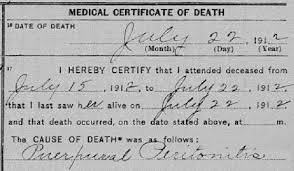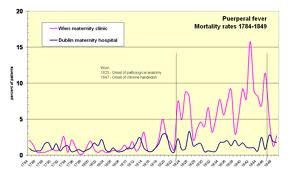
Puerperal Fever Dissolving Illusions: Disease, Vaccines, and The Forgotten History
Puerperal Fever (excerpt from Dissolving Illusions)
Vaccination Council SEPTEMBER 20, 2013
PUERPERAL FEVER

One of the ugliest, most tragic, and most avoidable chapters in the history of medicine is that of puerperal fever. Puerperal fever is the name given to a deadly infection that affected many mothers in the immediate post-partum period. Severe pain, pelvic abscesses, sepsis, high fever, and agonizing death were brought about by an ascending infection introduced by the contaminated hands of doctors and unsterile medical instruments. There is no single type of microorganism responsible, though the most common bacteria isolated after the germ theory was developed was Beta haemolytic streptococcus, Lancefield Group A.
In the United States, Europe, New Zealand, Sweden, and wherever conventional midwifery was abandoned and taken over by the new male midwives known as obstetricians and medical students, puerperal fever followed.
Man-midwifery was an uncertain but increasingly fashionable and sometimes quite lucrative area of practice for physicians; it may, for this reason, have been a field in which ideas about theory and practice were particularly strongly con-tested. Midwifery, formerly the preserve of women, was receiving increasing attention from medical men—both physicians and surgeons—during the eighteenth century. Prominent within this area of practice were the surgeons, for whom midwifery was seen as a natural extension of their activities. Surgeons had traditionally been called in to difficult births by midwives, usually when there was a need to extract an already dead foetus from the womb in order to save a mother’s life. During the eighteenth century, surgeons were increasingly finding ways to extend their practice into the area of normal childbirth. Men-midwives, although recognized by society as holding respectable positions and possessing expertise, found their status limited by the “hands-on” nature of their work. Nevertheless, within broader social terms, man-midwifery could be seen as a field of financial and career opportunity. These ambiguities and uncertainties within the status of men-midwives may have contributed to the intensity and competitiveness of the debates which can be found in their writings.[1]

Puerperal fever, also known as childbed fever, was a disease mediated by doctor arrogance. Dr. Oliver Wendell Holmes of the United States and Dr. Ignaz Semmelweis of Austria were prominent, long-suffering advocates for women, who tried to get the medical profession to wash their hands and practice more like the traditional midwives did. Both were ignored and even professionally attacked for their views. After years of mental anguish, watching women die needlessly, they left the field of medicine in disgust. Dr. Holmes became a writer. In 1865 Dr. Semmelweis was deceived into entering an insane asylum and when he tried to escape, he was severely beaten by guards. A gangrenous wound to his hand, probably caused by the beating, led to his untimely death two weeks later.
The reason it is important to never forget the history of puerperal fever is because the massive loss of maternal life impacted husbands, surviving infants, older surviving children, the family unit, society . . . and the statistics on life expectancy. Yet we rarely hear the words “puerperal fever” mentioned or discussed.
The epidemic of women and babies dying is documented from records as early as 1746, where more than 50 percent of mothers who gave birth in a Paris hospital died.[2] However, the best and most comprehensive writing on the problem came from Dr. Ignaz Semmelweis in his book, Etiology, Concept, and Prophylaxis of Child-bed Fever. After noting that the mothers who were tended by medical doctors had more than three times the rate of death than those who were tended by midwives and that those who were not internally examined lived, he suspected a contagious agent. Doctors often went from touching infected corpses in the cadaver dissection lab, to the maternity ward, where they examined women and delivered babies without handwashing.
Dr. Semmelweis directed the doctors of his hospital to use a chlorinated lyme solution on their hands prior to touching women. When doctors and medical students complied, the maternal mortality rate went from a high of 32 percent down to zero. Using a similar antiseptic technique, Dr. Breisky of Prague reported in 1882 that he delivered 1,100 women in succession without a single death.[3]
Dr. Semmelweis held several sequential staff positions, and wherever his hygiene method was followed, maternal mortality rates dropped. But most of his contemporaries ignored such outrageous and offensive “nonsense.”
Doctors were insulted at the suggestion that their hands were dirty[4], and many had the arrogance to continue to ignore factual evidence showing that they were the cause of maternal suffering and death up until the 1940s when antibiotics were invented.
After the invention of antibiotics, puerperal fever dropped significantly, but Semmelweis’ and Breisky’s records proved that doctors could have stopped almost all the puerperal fever deaths from occurring in the 1700s if they had only washed their hands and their instruments and stopped using unnecessarily invasive birthing techniques.
Another example, from Britain, was the widespread use of chloroform and forceps by general practitioners in uncomplicated deliveries between 1870 and the 1940s. This was described by one observer as a tendency a “little short of murder” and accounted for many unnecessary deaths.[5]
Considering that one-fifth of the population consisted of women of childbearing age and that a higher than 30 percent maternal mortality rate was not uncommon, the impact on society, life expectancy statistics, and the infectious disease rate (infants whose mothers died around childbirth had a four times higher risk of dying,most commonly from infections ) was enormous.
Yet vaccine enthusiasts never mention this tragedy in their assessment of history and infectious disease. Instead, vaccines are lauded as the great gift to humanity when, in fact, had doctors simply washed their hands, they would have prevented countless millions of deaths and raised the life expectancy curve markedly.
The end result of puerperal fever was millions of motherless children relegated to die, or to live a life of malnutrition and disease, often forced to work in mines, factories, and sweat shops. Puerperal fever fueled a social bonfire that left enormous damage in its path. If those infants had mothers to breastfeed them and love them and the older siblings had a mother at home to tend to their needs, the disease and misery of the 1700s to 1900s would have been far less prominent.
Doctors today believe that vaccines would have reduced those diseases, while they ignore the fact that their own predecessors created one of the situations which resulted in high disease rates and low life expectancy.
There are numerous reputable sources that clearly demonstrate how improved living conditions, more nutritious food, better obstetric care, and other non-vaccine elements were responsible for the decline in infectious disease death rates.
Despite this clear evidence, today’s vaccine proponents continuously and falsely claim that vaccines are the principal reason for the increase in life expectancy we enjoy today.
In Dissolving Illusions, you will be able to decide for yourself what makes more sense. Was it the vaccines? Or were there other factors that corresponded with the timing of decline in death rates? If so, are they to thank for our longer life expectancy? If the answer is that it was not the vaccines, should the World Health Organization (WHO) be working in a different direction today, in poor countries that mirror the conditions of our past?
If the medical profession could systematically misinterpret and ignore key historical information, the question must be asked, “What else is ignored and misinterpreted today?”
Dissolving Illusions available on AMAZON
REFERENCES
1 Christine Hallett, PhD, “The Attempt to Understand Puerperal Fever in the
Eighteenth and Early Nineteenth Centuries: The Influence of Inflammation
Theory,” Medical History, vol. 49, no. 1, January 1, 2005, pp. 1–28.
2. Ibid.
3. Frederick C. Irving, MD, “Oliver Wendell Holmes and Puerperal Fever,” New
England Journal of Medicine, vol. 229, no. 4, July 22, 1943, pp. 133–137.
4. Richard W. Wertz and Dorothy C. Weritz, Lying-In: A History of Childbirth in
America, Yale University Press, 1989, p. 122.
5. Irvine Loudon, “Maternal Mortality in the Past and Its Relevance to Develop-ing
Countries Today,”American Journal of Clinical Nutrition, vol. 72, suppl. 1, July
2000, pp. 241S–246S.